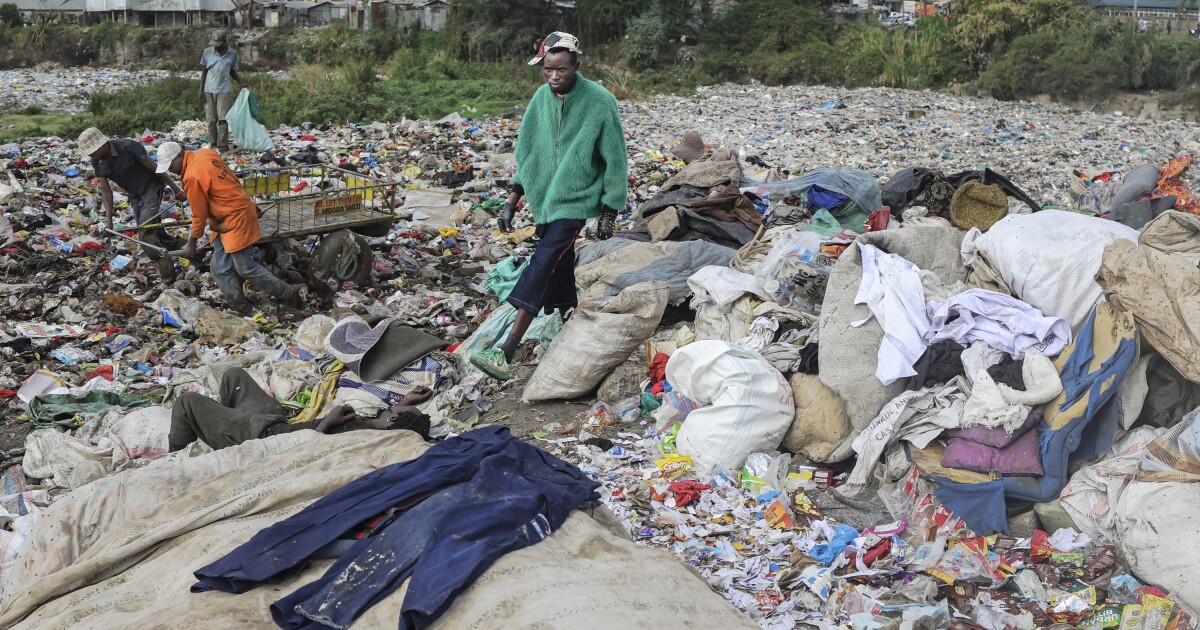More for families.
If you’re enjoying this article, you’ll love LAist’s early childhood newsletter. Every two weeks, you’ll receive top reads and resources on issues affecting families with kids ages 0–5.
This weekend in downtown L.A., a group of worldwide experts on fashion sustainability will be in conversation with their California counterparts. Their goal is to help make a dent in an unsustainable fact: People around the world generate 92 million tons of textile waste each year.
“We see just so much waste that is extra clothing that is produced that is not needed,” said Dennita Sewell of Arizona State University Fashion Institute of Design & Merchandising (ASU FIDM). She’s one of the organizers of the conference scheduled for Saturday and Sunday. (It’s free and open to the public.)
“Another issue is getting rid of things, how things are reused or disposed of when people are finished with them,” she said.
Awareness of the problem is leading to changes to the way clothes are designed, the creation of more sustainable material and reduction of the abuse of humans and the environment in the making of clothes.
A new generation of fashion designers
A student at ASU FIDM works on a knitting machine during the Knitwear Design course.
Fashion design schools like ASU FIDM are on the front lines of rethinking design.
For their culminating projects last year, some ASU FIDM students created fashion collections out of reused, or upcycled, textiles and materials. They repurposed existing garments to completely transform them into something new.
“Undergraduate students right now, they are really genuinely concerned, and that gives me a lot of hope,” Sewell said.
She said she’s also teaching the kind of design that will prompt consumers to keep and wear a garment for a longer period of time.
Industry eyes are on California
Some of the visitors from Europe said there’s a perception in their home countries that efforts to reduce waste in the U.S. are being abandoned as a result of President Donald Trump’s policies.
An ASU FIDM student arranges pattern pieces in the studios of the ASU California Center Grand in downtown Los Angeles.
(
Derren Versoza
/
Courtesy ASU FIDM
)
“We really wanted to see if that was true,” said Ian King, founder of the International Responsible Fashion Series and a former professor at the University of the Arts in London. He and others spent the past week before the conference visiting the San Joaquin Valley and other parts of the state to see for themselves what was happening.
“What we have found already in these last few days is it’s not true because the industry itself does believe that it needs to take a much more responsible attitude towards the future of fashion,” King said.
He said he’s found a greater desire to make fashion sustainable among California clothing consumers and manufacturers.
King spoke to LAist from a cotton field in Central California. He and other conference participants were touring the field managed by a company that sustainably cultivates the cotton plant using fewer fertilizers and other harsh chemicals in the production process.
A model wears a look from recent ASU FIDM BA fashion graduate Riley Kennedy, crafted from upcycled fabric scraps.
They’re also watching California’s newly enacted law that will compel textile manufacturers, starting in 2028, to be held accountable for the disposal of the product they produce when it’s at the point of being discarded.
The various definitions of ‘sustainable fashion’
Conference participants said there is no one definition of sustainable fashion. The phrase can mean personal approaches to radically cut down the size of your wardrobe, called minimalism, to designing clothes that are not based on trends and, therefore, are worn longer to reducing the exploitation of people and the environment by clothing manufacturers.
Undergraduate students right now, they are really genuinely concerned, and that gives me a lot of hope.
— Dennita Sewell, director of Arizona State University Fashion Institute of Design & Merchandising
Stefanie Mallon, a cultural anthropologist and textile scientist at the University of Göttingen, in Germany, is presenting a session titled “What Is Sustainability in Fashion?”
She’s traveled in Central Asia, she said, and found that people’s definition of responsible fashion is different there than in other parts of the world. There, she said, people are returning to the slower, handmade creation of garments that are rooted in cultural practices. The resulting clothes have deeper meanings for people, she said, and have longer lifespans.
There’s no escaping a paradox, she said, that’s central to the problem of textile waste in the world.
“Fashion is, on the one hand, something that you have to buy,” she said. “At the same time, these products are the problem, as well.”

